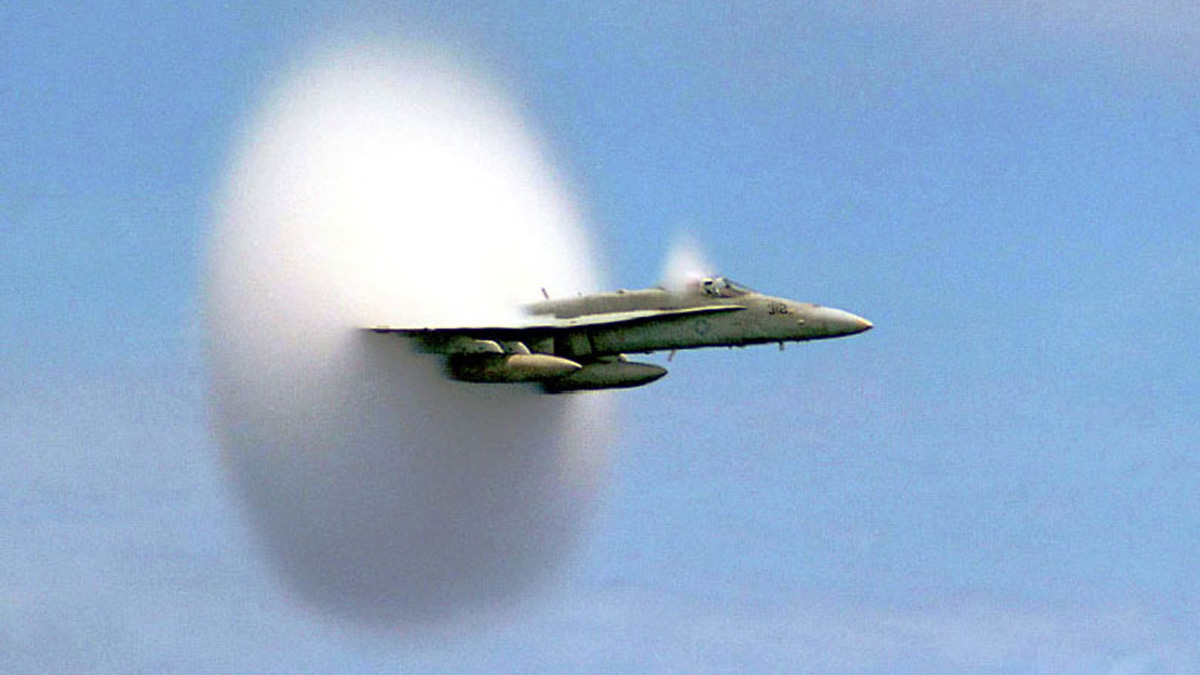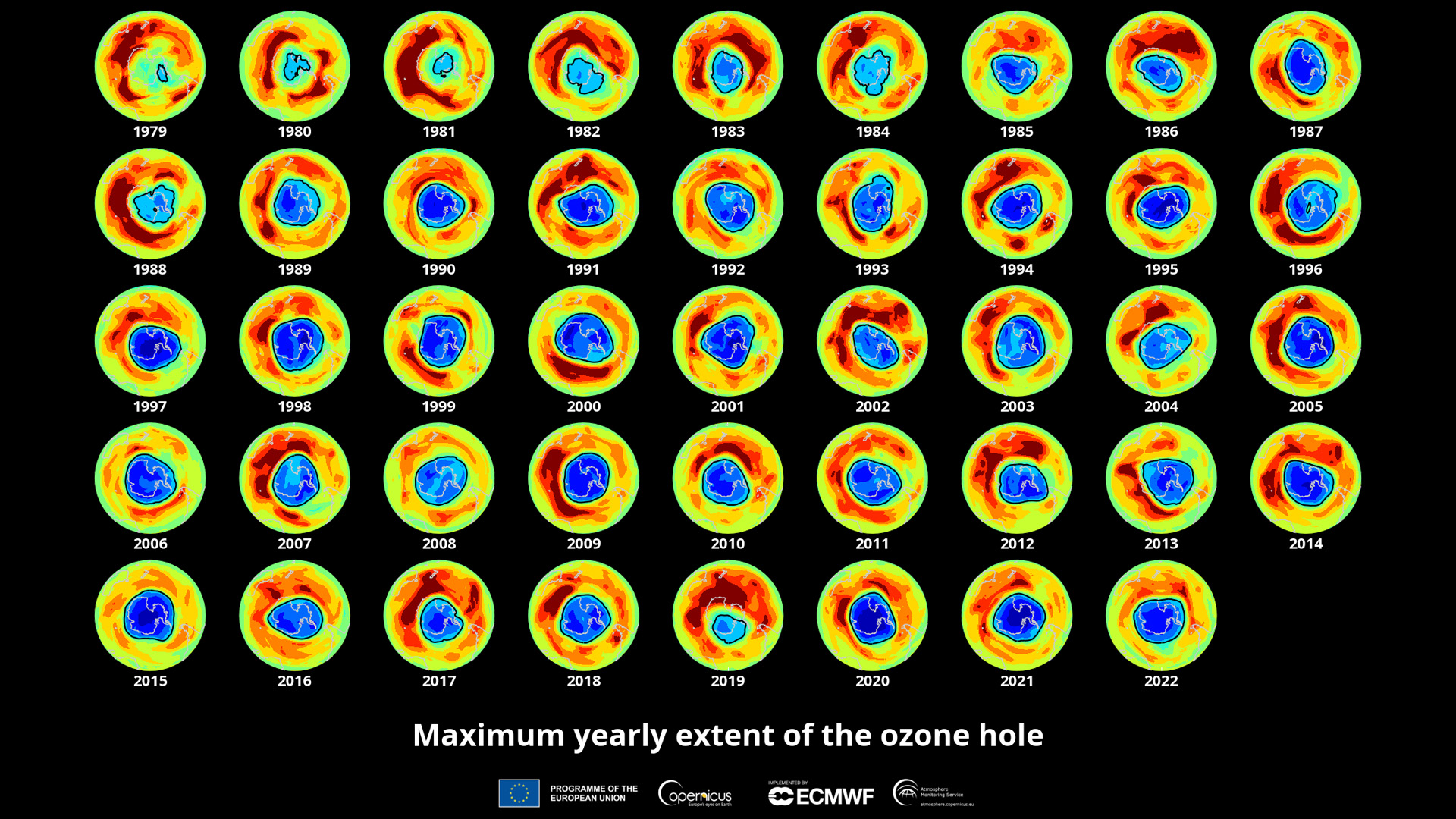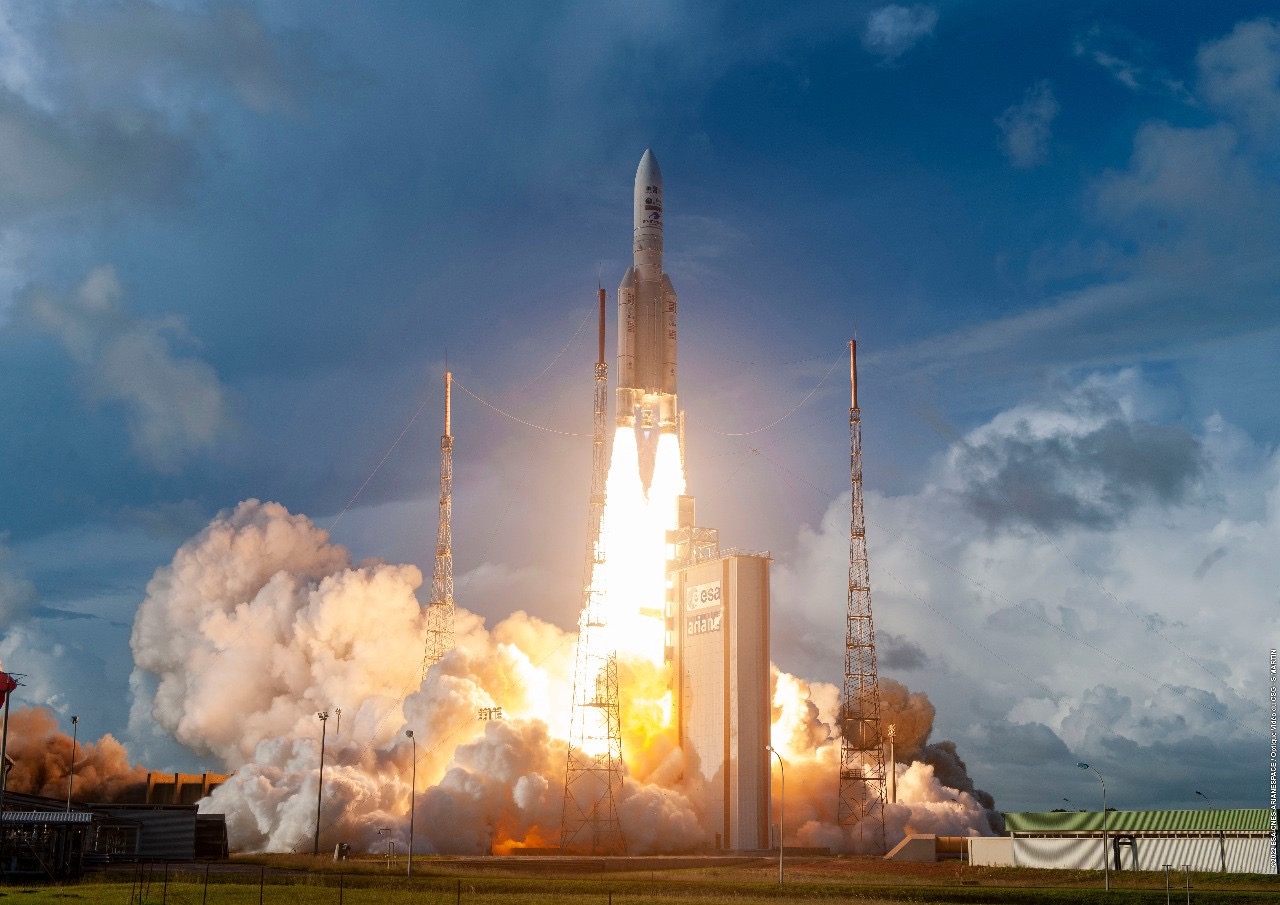Supersonic planes, rockets and megaconstellations could thwart ozone layer's recovery
The ozone layer is on the mend but not completely out of the woods yet.

The atmosphere's ozone layer was devastated in the 20th century by chemicals in aerosol sprays and refrigerators, but is now recovering and might even fully heal in a few of decades, a new scientific assessment estimates. However, new technologies are emerging that might thwart this global healing process.
Ozone, a molecule consisting of three oxygen atoms that is distributed throughout the lower parts of the stratosphere (the second lowest layer of Earth's atmosphere), blocks damaging ultraviolet radiation from the sun that can damage living tissues, cause cancer and harm eyesight. Since the 1980s, when the depletion of ozone in the stratosphere and the gaping hole in the ozone layer above Antarctica were first discovered, the world has come a long way toward mitigating or healing that damage.
The Montreal Protocol, put in place in 1987, led to the global phase-out of the most offending ozone-depleting substances, chlorofluorocarbons, which had been introduced in the 1950s as a propellant in aerosolized chemical sprays and refrigerant in air conditioning systems, cars and refrigerators.
A report by the World Meteorological Organization (WMO) released on Jan. 9 states that the ozone layer is on track to completely recover within four decades. But it also names four nascent technologies that could set the healing process back in the future.
Here, world's leading experts give their views on the situation.
Related: The environmental impact of rocket launches: The 'dirty' and the 'green'
1. Satellite mega-constellations
Nearly 6,000 active satellites are currently orbiting Earth, more than ever before in human history. By 2030, this number may rise to a staggering 58,000 according to an assessment by the U.S. Government Accountability Office (GAO). Most of these satellites will belong to mega-constellation operators such as SpaceX's Starlink, OneWeb or Amazon's Kuiper. The majority of these satellites will reside in low Earth orbit, the region of space below 1,200 miles (2,000 kilometers), and will be regularly replaced by newer, more advanced models. That means that within a decade, huge amounts of old defunct spacecraft will be burning in Earth's atmosphere as gravity drags the old unwanted satellites back to the planet.
Get the Space.com Newsletter
Breaking space news, the latest updates on rocket launches, skywatching events and more!
These satellites are made of metals such as aluminum and titanium and contain other potentially toxic substances. Scientists worry that as these satellites burn, they may release harmful chemicals that could damage the recovering ozone layer.
"The disposal of satellites from these large low Earth orbit constellations into the atmosphere and their vaporization during reentry is a very significant potential impact both for the climate and the ozone layer," Martin Ross, a researcher at the Aerospace Corporation in California who studies effects of space systems on the stratosphere, told Space.com. "Right now, we know very little about what happens when these satellites vaporize and turn into particles and gases. We don't know how active these particles and gases are both chemically and radiatively. But we know that soon, there will be tons of this stuff coming down."
Aluminum oxides, which may be produced during the burn-up of the aluminum-based spacecraft bodies, have been linked to ozone destruction in the past. The burning of titanium could generate titanium oxides, which, Ross said, can alter the optical properties of the surrounding air. There are other contentious elements present in satellite components — cobalt and lithium in batteries, traces of gold and lead — all elements that are not otherwise found in the upper atmospheric layers.
"There's the potential for a surprise, in terms of chemical reactivity with ozone," Ross said. "That's what needs to be understood. What these particles are and what is their chemical reactivity."

Supersonic aviation
Supersonic aircraft, such as the now retired Concorde, cruise at higher altitudes than conventional jet liners. Flying over 60,000 feet (18.3 kilometers) above Earth's surface, Concordes and other supersonic planes such as those used by the military release pollutants into the lower stratosphere where the protective ozone layer resides. The WMO report estimates that if supersonic aviation was to enter the mainstream, its emissions could "reduce the total ozone column by as much as 10%."
"New supersonic and hypersonic aircraft are being developed that can release water vapor and nitrogen oxides into the stratosphere," Paul Newman, the chief scientist for Earth sciences at NASA Goddard Space Flight Center, who collaborated on the WMO report, told Space.com. "At this point, there are not enough of them, but in the future, if you began to fly thousands of these aircraft in the stratosphere, it could have a significant effect."
Although the Concorde fleet operated by British Airways and Air France was retired in 2003 after passenger interest nosedived in the aftermath of a fatal crash in 2000, airlines all over the world are now looking forward toward a new generation of supersonic planes that is currently being developed.
U.S.-based Boom Supersonic recently unveiled the innovative Symphony engine for its supersonic passenger plane called Overture, which, the firm hopes, could start flight-testing by the end of this decade.
NASA, too, has stakes in the new supersonic aviation business, with its experimental X-59 plane that aims to eliminate the obtrusive noisiness traditionally associated with supersonic air travel.

Too many rocket launches
The WMO report also states that while currently rocket launches only account for about 0.1% of the detectable ozone destruction, this number may grow in the future as the amount of rocket launches is expected to increase.
New rocket propulsion systems are being developed that consume presumably greener hydrogen and methane fuel, but scientists warn that not enough is known about the interaction of the exhaust fumes from these rocket motors with the upper layers of Earth's atmosphere, the stratosphere, which harbors the ozone layer, and the even higher mesosphere.
Ross hopes that the world's space and atmosphere research agencies will soon take their high-altitude aircraft to the stratosphere to measure what exactly happens high above Earth when rockets guzzling fossil fuels and greener alternatives, such as hydrogen and methane, pass through.
"We want to do the same that we did 25 years ago when solid rocket motors were considered a threat to the ozone layer," Ross said. "NASA, NOAA (the U.S. National Oceanic and Atmospheric Administration) and the U.S. Air Force all got together and made measurements in the actual plumes in the stratosphere. And thanks to that we were able to find that the solid rocket motors weren't as bad as some models were suggesting."

Geoengineering
The experts also worry that possible geoengineering interventions, attempts to slow down climate change by artificial means, could affect the ozone layer. There are no such plans yet, but for years, scientists have studied methods that could help reduce the amount of heat that gets trapped in Earth's atmosphere by increasing the albedo, or reflectiveness, of the air around our planet. Such effects have been observed after powerful volcanic eruptions that inject large amounts of sulfur-rich ash into the stratosphere. Famously, after the eruption of Mount Pinatubo in the Philippines in 1991, global average temperatures dropped by about 1 degree Fahrenheit (0.6 degree Celsius). The effect was measurable for at least 15 months.
Procedures have already been outlined that could mimic these processes in a calculated way. Newman, however, cautions that the side effects of such interventions are not understood at all.
"People are beginning to look at stratospheric aerosol injection (SAI) as a potential band aid, to allow us to get to the future where we will have reduced carbon dioxide emissions," Newman said. "It's something that we might consider doing in case of catastrophic climate change — massive floods, heatwaves leading to multiple deaths, the destruction of crops. The problem is that our models don't do a great job of simulating the effects of SAI. We know that it would change the stratosphere by a lot so there is a concern that it could make the ozone hole over Antarctica more severe."
Nonetheless, the Montreal Protocol remains a great success of humankind's ability to unite and ward off the self-imposed destruction of our environment. The ozone layer may not be completely out of the woods yet, but scientists hope that lessons learned in the effort to save it may inform our still undecided battle against climate change.
Follow Tereza Pultarova on Twitter @TerezaPultarova. Follow us on Twitter @Spacedotcom and on Facebook.
Join our Space Forums to keep talking space on the latest missions, night sky and more! And if you have a news tip, correction or comment, let us know at: community@space.com.

Tereza is a London-based science and technology journalist, aspiring fiction writer and amateur gymnast. Originally from Prague, the Czech Republic, she spent the first seven years of her career working as a reporter, script-writer and presenter for various TV programmes of the Czech Public Service Television. She later took a career break to pursue further education and added a Master's in Science from the International Space University, France, to her Bachelor's in Journalism and Master's in Cultural Anthropology from Prague's Charles University. She worked as a reporter at the Engineering and Technology magazine, freelanced for a range of publications including Live Science, Space.com, Professional Engineering, Via Satellite and Space News and served as a maternity cover science editor at the European Space Agency.









